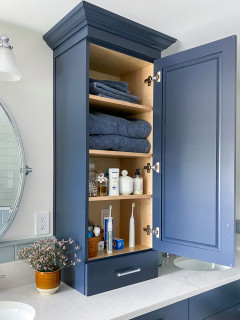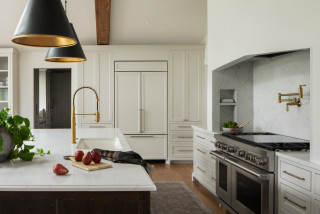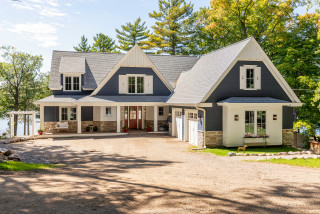
This article was originally published by a www.houzz.com . Read the Original article here. .

This article was originally published by a www.houzz.com . Read the Original article here. .

In most kitchens, the dishwasher is conveniently located next to the sink to simplify loading. When laying out your space, also think about the ease of unloading clean dishes and flatware. Consider where you’ll be standing when the dishwasher door is open and how easily you’ll be able to access drawers and storage.
Since emptying the dishwasher is a frequent task, convenient access to storage should be a priority. I have seen several kitchens where an open dishwasher door blocks access to storage for dinnerware and flatware. Other kitchen layouts require walking across the room to put away dishes. Also make sure there’s plenty of space to stand at the sink when loading the dishwasher.
This article was originally published by a www.houzz.com . Read the Original article here. .

When designing this Norwood Township, Michigan, home for a retired couple with a large extended family, architectural designer Stephanie Baldwin of Edgewater Design Group took to heart the homeowner’s inspiration images of traditional Shingle-style homes and created something worthy of a Nancy Meyers movie. The welcoming front porch has an arched roofline echoed by the arched front door, the columns have real stone veneer at their bases and the bay on the right has a copper standing-seam roof.
To ensure that the lakeside home could survive the harsh climate and blowing sands from the Lake Michigan shoreline, Baldwin specified low-maintenance exterior materials, including vinyl shake shingles for the siding. Zip sheathing on the north- and west-facing sides of the house adds extra insulation and waterproofing.
This article was originally published by a www.houzz.com . Read the Original article here. .

Whether you choose a fixed or hourly fee strategy, it’s important to be consistent. Any changes to this could reduce your client’s confidence.
Gemma Hill of Bayswater Interiors says her firm uses an hourly pricing structure, as they feel it’s fair for both parties. “Clients only pay for what we’ve provided,” she says. “In the past, we’ve had projects where clients have increased the scope of our work, or changed their minds unexpectedly midway through the process, and expected us to start again to incorporate their new ideas, which ended up costing us money in lost hours. This way, we’re invoicing for work completed and are not out of pocket, and this is clear and fair to the client throughout.”
Nicholls, on the other hand, prefers a fixed pricing structure. “When we put together our fee proposal, we estimate the amount of time we’ll spend on a project, using similar jobs as a benchmark,” she says. “Once we’ve given our fee proposal, our fee doesn’t change unless the scope of work changes or there are unforeseen circumstances. We would then discuss this with our client and adjust the fee if necessary.”
Find out how Houzz Pro can help you run your business
This article was originally published by a www.houzz.com . Read the Original article here. .
Functional hardware is a bonus upgrade with one of the greatest rewards. Your drawers can be pulled out completely with full-extension slides, allowing an entire view of and access to the drawer. Items in your drawer won’t be hidden, and the drawer may be easier to clean as well. Even if your remodel includes keeping your existing drawers and cabinets, most can be easily retrofitted with full-extension slides.
Soft-close slides and hinges prevent drawers and cabinet doors from slamming shut, instead closing them softly and silently. This not only reduces noise but also minimizes wear and tear on the drawers, doors and hinges and prevents contents from shifting too much. Additionally, soft-close slides can help keep children’s fingers from getting pinched by a fast-closing drawer.
For deep cabinets, items stored in the back may be awkward to retrieve and therefore become lost and forgotten. I recommend rollout shelves (with full-extension slides, of course) in these spaces so you can see all the contents. Since access is much more convenient, you may be encouraged to put things away properly and more efficiently.